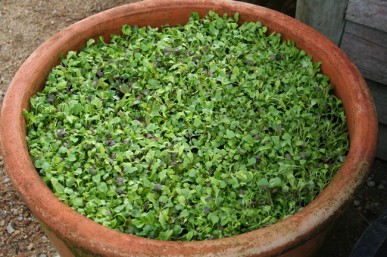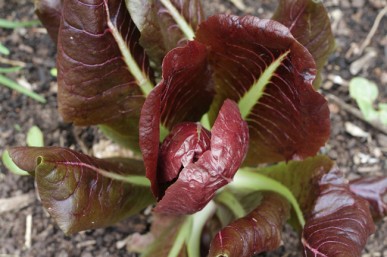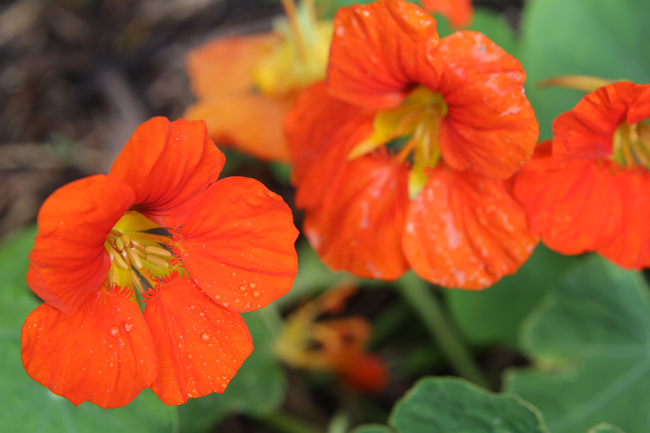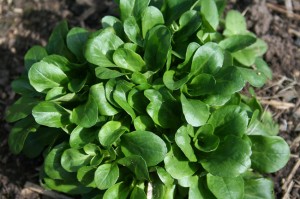 According to recent research (see below) and reported on Science Daily microgreens are higher in a range of nutrients than their more adult forms. My favourite microgreens are young leafy salad plants like lettuce, spinach, mizuna, and rocket, but red cabbage, bok choy, kale and mustard are also delicious. Throw in a few garlic chive or onion seeds to add piquancy, as well basil or dill and you will have a truly multicultural mix. Microgreens are sown into soil (I use potting mix) in seed trays or pots. Keep them just moist in a sunny position and two to three weeks later they are ready to harvest. Just cut them with scissors, add to salad, use as a garnish or sprinkle over a sandwich. Not only do they taste great but research has shown that healthy vitamins and carotenoids are found in larger amounts than their mature counterparts. For example, red cabbage microgreens are high in vitamin C, while green daikon radish microgreens were rich in vitamin E. Anyone with a sunny windowsill can grow microgreens, so why not buy some seed (both Diggers and Green Harvest sell seed), alternatively it is a great way to use up your old packets of herb and vegetable seed.
According to recent research (see below) and reported on Science Daily microgreens are higher in a range of nutrients than their more adult forms. My favourite microgreens are young leafy salad plants like lettuce, spinach, mizuna, and rocket, but red cabbage, bok choy, kale and mustard are also delicious. Throw in a few garlic chive or onion seeds to add piquancy, as well basil or dill and you will have a truly multicultural mix. Microgreens are sown into soil (I use potting mix) in seed trays or pots. Keep them just moist in a sunny position and two to three weeks later they are ready to harvest. Just cut them with scissors, add to salad, use as a garnish or sprinkle over a sandwich. Not only do they taste great but research has shown that healthy vitamins and carotenoids are found in larger amounts than their mature counterparts. For example, red cabbage microgreens are high in vitamin C, while green daikon radish microgreens were rich in vitamin E. Anyone with a sunny windowsill can grow microgreens, so why not buy some seed (both Diggers and Green Harvest sell seed), alternatively it is a great way to use up your old packets of herb and vegetable seed.
(Zhenlei Xiao, Gene E. Lester, Yaguang Luo, Qin Wang. Assessment of Vitamin and Carotenoid Concentrations of Emerging Food Products: Edible Microgreens. Journal of Agricultural and Food Chemistry, 2012; 60 (31): 7644 DOI: 10.1021/jf300459b)

Red leafed chicory

Chicory flower
These plants do well in most soils and like full sun to semi-shade, are easily grown from seed and become bitter once the plants start to flower and go to seed. But before that happens you will get months of delicious and healthy leaves.
Chicory Cichorium intybus is a herbaceous perennial that grows from a strong tap root with large leaves. Blue flowers appear on long stalks in the second year. It is frost and drought tolerant, and makes a good winter salad crop in cooler regions. Young leaves have a delicious slightly bitter flavour. Older plants are eaten as vegetables. Some varieties are ‘Red Treviso’, ‘Palla Rossa’, ‘Catalogna Emerald’. Endive Cichorium endiva is closely related to chicory, grows in the same way and is a useful cool season salad plant. The flavour is mild, nutty and less bitter. Some varieties are ‘Pancalleri Fine Cut’, ‘Blonde Full Heart’, ‘Moss Curled’. Read more

Succulent, peppery watercress
Watercress (Nasturtium officinale) is a sprawling much-branched, aquatic, perennial plant, with a low, creeping growth habit, with heart-shaped, bright green leaflets and white flowers. Roots grow from nodes where they touch the ground. It is really easy to grow, if you buy a bunch of watercress, just plonk one piece into a glass of water and within a few days it will have produced roots. You can also grow it from seed.
Ideally watercress should be grown in running water, but it survives well in a pond, planted in a pot submerged in the water, as long as it is regularly sprayed with fresh water. Once a week is enough. Alternatively grow it in a pot sitting in another container full of water that is also regularly topped up. Watercress likes a humus-rich, fertile soil and full sun or partial shade. Once plants are growing well remove any flower heads to promote leaf growth and prolong harvest. Read more

Bright orange, edible nasturtium flowers
One of the most cheerful plants in my garden at present are the nasturtiums (Tropaeolum majus). The bright yellow, orange and red flowers are jewel-like highlights, scattered around the garden, in odd spots, tumbling over other plants. Nasturtiums grow easily from seed sown where they are to grow and once established they will grow, flower and set seed for months. Intense heat, or later cold and frost kill them off but in my garden they reappear every spring, colonizing waste spaces and protecting soil until I am ready to pull them out and plant something else. The only work involved in looking after them is to keep them under control. Any plants that you don’t want are simply pulled out and added to the compost where they rapidly break down. Read more

Corn salad has mild, almost melt in the mouth leaves
The lovely autumn days entice me into the garden where I have been madly weeding and cutting back the prolific summer growth. I love this time of year when the soil is still warm, so plants are still growing, but the intense heat has gone. Two plants that come into their own now are corn salad and landcress. These are both annuals (landcress is sometimes biennial) that self sow around my garden providing salad greens right though autumn and winter.
Corn salad (Valerianella locusta) is also known as lamb’s lettuce, and has a delicate very mild flavour with soft leaves that almost melt in the mouth. The leaves are pale green and rounded and grow in small clumps. You can pick the leaves individually or cut whole plants just above the ground, they will re-shoot. Plants only reach about 30cm in height. There are cultivars with golden, extra large and darker green leaves. Grow corn salad in temperate and cold regions from seed sown in autumn, winter and spring—in hot weather it goes to seed almost immediately. I find that mine goes to seed in spring, then disappears until autumn when the plants appear again in a dense clump. Read more
 According to recent research (see below) and reported on Science Daily microgreens are higher in a range of nutrients than their more adult forms. My favourite microgreens are young leafy salad plants like lettuce, spinach, mizuna, and rocket, but red cabbage, bok choy, kale and mustard are also delicious. Throw in a few garlic chive or onion seeds to add piquancy, as well basil or dill and you will have a truly multicultural mix. Microgreens are sown into soil (I use potting mix) in seed trays or pots. Keep them just moist in a sunny position and two to three weeks later they are ready to harvest. Just cut them with scissors, add to salad, use as a garnish or sprinkle over a sandwich. Not only do they taste great but research has shown that healthy vitamins and carotenoids are found in larger amounts than their mature counterparts. For example, red cabbage microgreens are high in vitamin C, while green daikon radish microgreens were rich in vitamin E. Anyone with a sunny windowsill can grow microgreens, so why not buy some seed (both Diggers and Green Harvest sell seed), alternatively it is a great way to use up your old packets of herb and vegetable seed.
According to recent research (see below) and reported on Science Daily microgreens are higher in a range of nutrients than their more adult forms. My favourite microgreens are young leafy salad plants like lettuce, spinach, mizuna, and rocket, but red cabbage, bok choy, kale and mustard are also delicious. Throw in a few garlic chive or onion seeds to add piquancy, as well basil or dill and you will have a truly multicultural mix. Microgreens are sown into soil (I use potting mix) in seed trays or pots. Keep them just moist in a sunny position and two to three weeks later they are ready to harvest. Just cut them with scissors, add to salad, use as a garnish or sprinkle over a sandwich. Not only do they taste great but research has shown that healthy vitamins and carotenoids are found in larger amounts than their mature counterparts. For example, red cabbage microgreens are high in vitamin C, while green daikon radish microgreens were rich in vitamin E. Anyone with a sunny windowsill can grow microgreens, so why not buy some seed (both Diggers and Green Harvest sell seed), alternatively it is a great way to use up your old packets of herb and vegetable seed.




